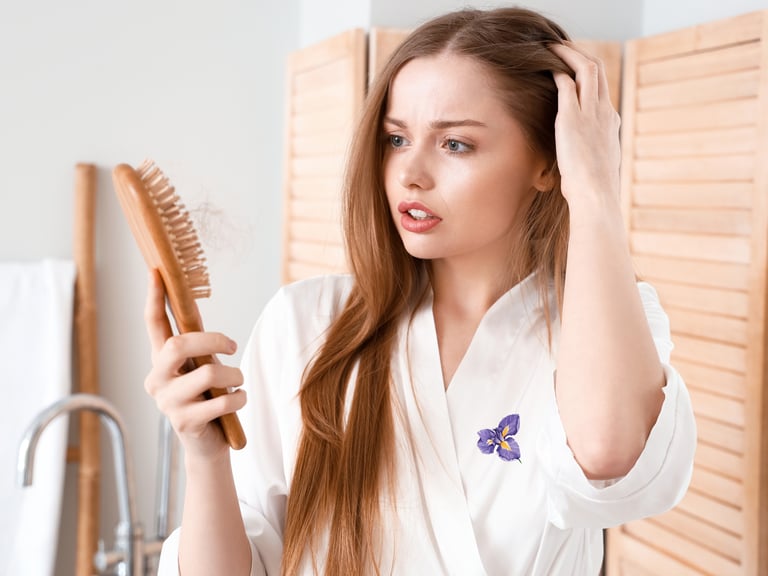Understanding Alopecia Areata: Causes, Symptoms & Modern Treatment Options
11/14/20252 min read


Alopecia Areata is an autoimmune condition that causes sudden, patchy hair loss on the scalp, eyebrows, eyelashes, or other areas of the body. It can appear without warning, creating smooth, round bald patches that may expand or regrow unpredictably. While the condition is not physically harmful, its emotional impact can be significant—making awareness, early diagnosis, and proper treatment essential.
What Causes Alopecia Areata?
Alopecia Areata occurs when the immune system mistakenly targets hair follicles, causing them to enter a resting phase rather than continue growing. The exact cause is still unknown, but several factors can contribute to its development:
Genetics: A family history of autoimmune conditions increases the likelihood.
Immune triggers: Stress, illness, or infection may play a role.
Other autoimmune conditions: People with thyroid disease, vitiligo, or allergies are at slightly higher risk.
Despite these associations, Alopecia Areata can affect anyone—men, women, and children of all ages.
Recognizing the Symptoms
The hallmark sign of Alopecia Areata is patchy hair loss. Common features include:
Smooth, round or oval bald patches
Possible tingling, itching, or mild discomfort before hair falls out
“Exclamation mark hairs”—short, broken hairs that taper at the base
Nail changes (ridges or pitting) in some individuals
Hair may regrow spontaneously, fall out again, or cycle between the two. Severity varies widely; some experience only a small patch, while others may develop Alopecia Totalis (loss of all scalp hair) or Alopecia Universalis (loss of all body hair).
Treatment Options: What Really Works?
While there is no cure, many people experience significant regrowth with the right approach. Treatment depends on the size, location, and duration of hair loss.
1. Corticosteroid Injections
Often considered first-line for small patches, these injections reduce inflammation around the follicles, encouraging regrowth within weeks.
2. Topical Corticosteroids
Creams or foams can help mild cases or be added alongside injections for stronger results.
3. Minoxidil (Topical) - Over the Counter
While Women’s ROGAINE® 5% Foam is specifically formulated and FDA-approved for women, some women successfully use the Men’s 5% Foam off-label, as both contain the same active ingredient, minoxidil. It’s important to apply it once daily to a clean, dry scalp, ideally after inflammation or irritation has been controlled. Minoxidil works as an adjunct treatment by stimulating hair follicles and prolonging the growth phase, supporting regrowth over several months of consistent use. Always monitor for side effects and consult a dermatologist before using the men’s version.
4. Topical Immunotherapy
Medications like DPCP or SADBE create a controlled allergic reaction that redirects the immune system away from attacking the follicles. This is especially useful for more extensive or stubborn cases.
5. JAK Inhibitors (New Breakthrough Treatments)
Oral medications such as baricitinib or ritlecitinib target the immune pathways involved in Alopecia Areata. These have brought dramatic results for many people with moderate to severe hair loss and represent a major advancement in treatment.
6. Additional Supportive Options
PRP (platelet-rich plasma)
Anthralin
Excimer laser treatments
Wig and hair systems for emotional support and confidence
Living With Alopecia Areata
Alopecia Areata can be unpredictable, but many people experience regrowth—sometimes fully, sometimes partially. The emotional burden can be heavy, and seeking support is just as important as medical care. Connecting with others who understand the journey can be empowering.
Self-care strategies like stress management, gentle scalp care, and lifestyle balance can also support overall wellbeing, even though they aren’t direct cures.
Final Thoughts
Alopecia Areata is a complex but manageable condition. With advancing treatments, greater awareness, and supportive care, many individuals can regain confidence and see significant improvement in hair growth. Early diagnosis by a dermatologist gives the best chance for positive outcomes, and continuing research offers increasing hope for long-term solutions.
